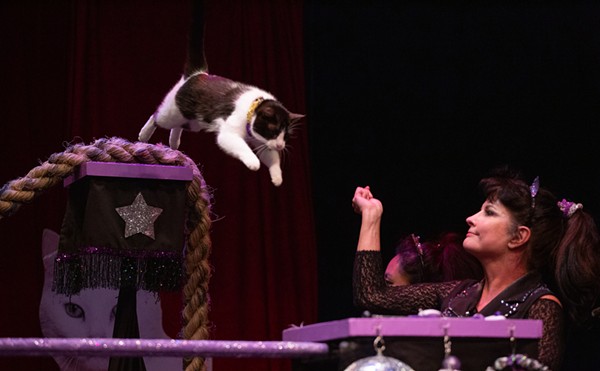| Jordan Ty Mylnar and Alysia Livingston play the famously star-crossed lovers in Trinity’s production of Romeo and Juliet, set in modern-day Fiesta. |
| Romeo and Juliet 8pm Fri-Sat, 2:30pm Sun Through Nov 19 $10 general; $5 student, senior, military St. Philip’s College Theatre 1801 Martin Luther King Dr. 531-3321 Romeo and Juliet 7pm Wed-Thu, 8pm Fri-Sat Through Nov 18 $8 general; $6 Trinity faculty & alum; $5 student Stieren Theater Trinity University One Trinity Place 999-8515 |
Director Vincent Hardy aims for contemporary minimalism in St. Philip’s Brazilian rendition of the play. The set, a simple structure covered in painted red letters that envelop the entire stage and seep onto the floor, acts as the backdrop for an apocalyptic interpretation of the 17th-century epic. The actors set out to adapt Shakespearean violence and love to a poverty-stricken favela (Brazilian shantytown) in the year 2010. Hardy uses the violent division in Shakespeare’s play as a parallel to rising conflict and bigotry in the contemporary world.
Innovative costuming adequately complements this futuristic rendition, from clergymen cloaked in blazers, jeans, and boots, to an impassioned Romeo in screen-prints and purple. The keen integration of the Brazilian martial art Capoeira as the vehicle for the interpretation of each fight scene results in original choreography. This sweeping visual dialogue reinvents the implications of physical conflict and beautifies each deathly encounter; the violence of Shakespeare has a new taste as the usual chaos of confrontation finds fluidity in dance. This rendition of murder and brawling reinvents the language of the play and actually intensifies each character’s imminent death.
The careful choreography is complemented by a crescendo of Brazilian music steeped in heavy beats and increasing tempo. I found myself waiting for the next character to die, anticipating another carefully choreographed scene.
Although the body language and stage presence was exceptional, the difficulties of Shakespearean rhythm proved to be a challenge for many of the actors. Iambic pentameter was at times muddled and often the actors stumbled through parts of speech, racing past voice inflection or rhythmic understanding. This lack of vocal discipline, however, was not widespread and the difficult translation of heightened emotion was ultimately successful.
Actor Paul Trujillo tactfully translates the fickle, adolescent, and often peevish disposition of the love-struck Romeo. His vocal delivery was both authentic and confident and the actor’s interpretation of rash love convincing. Comedic relief, found in the playful antics of actor Robert Jerdee’s rendition of the rowdy and conniving Mercutio, incorporates both the sexy and violent aspects of the bard’s tale. His presentation of the well-known Queen Mab soliloquy, complete with gesticulating hips and overt sexual innuendos, was eloquently delivered and successfully translated the fantastic imagery of this dream fairy’s tale.
Male roles expressed by female actors are common in Hardy’s interpretation. Benvolio, played by Laura Milligan, is one of many gender-switched characters and the actress successfully expresses the wild temperament of adolescent boys. St. Phillip’s conceptualizes a Romeo and Juliet of new proportions and seeks to point out the futility of violence in today’s world.
Across town, Trinity University boasts a much larger production, complete with moving sets and spotlighting. The vast differences between Hardy’s minimalist tendencies and the grandeur of director Roberto Prestigiacomo’s style makes for a different Shakespeare experience. Set in present-day San Antonio during Fiesta, such locations as the Alamo and Sam’s Burger Joint serve as the backdrop for much of the play.
Complete with mariachi music, colorful papel picado, and luminescent strings of party lights, this version expresses the true adolescence of many of the characters. The opening scene likens to a frat party, as Samson Capulet (Britt Moreno) swigs from cans of Pabst Blue Ribbon and flamboyantly shoots the bird at Abram and Balthasar Montague (Chris Crawford and Nathan Thurman). The resulting brawl is marked by chaos and is choreographed in a less fluid manner than the St. Phillip’s production, creating a fight scene that actually resembles painful confrontation.
Shakespearean violence, Trinity-style, is overtly graphic. The students incorporate knives, guns, and even fake blood for a realistic portrayal of murder and suicide. The costuming employs conventional teenage clothing — Romeo sports skateboarding shoes and The Ensemble wears mini skirts and sexy stilettos. The costume ball in Scene V depicts the characters in masquerade and creatively costumes Romeo and Juliet in traditional Old English Romeo and Juliet outfits. This double entendre adds to the comic relief and is a clever reference to the Shakespearean era.
Lead actors Jordan Ty Mylnar (Romeo) and Alysia Livingston (Juliet) exhibit a natural ability to interpret Shakespearean text and adequately translate the archetypal love story. At times, the overuse of body language and romantic music was flamboyant and distracting — however Livingston points out that teenage love is often steeped in melodrama. Although I have never seen love-struck teens frolicking in a church as Trinity’s Romeo and Juliet did, I can agree that young hearts are often more in love with the idea of love than the reality of life.
This detachment from reality is, in actuality, the essence of the play. Many characters are so lost in their own prejudice, hatred, and inability to communicate that they lose sight of reality. Lady Capulet, played by Rachel Spencer, epitomizes this inability to create honest and understanding relationships, deftly manipulating the dialogue to create an upper-class mother-type that cannot sympathize with the needs of her daughter.
Overall, the actors were well-prepared in stage direction, choreography, and speech, and this student production is a successful developmental study for the careers of these young dramatists.

















